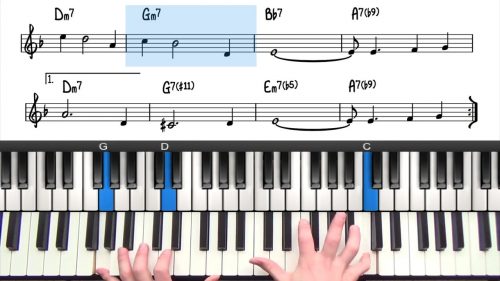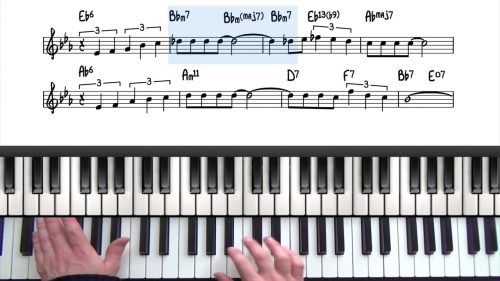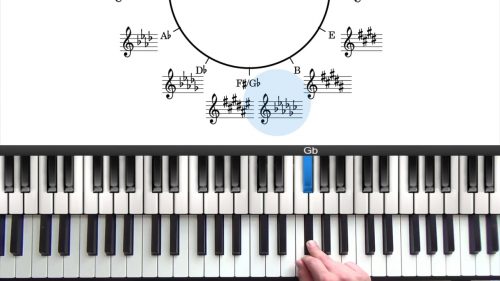How To Play Block Chords
Block chords are a method of harmonising a melody line by moving all the notes of the chord in parallel, following the same rhythm as the melody.
Harmonising melodies with block chords is also known as ‘locked-hands’ so be aware that these terms refer to the same thing.
In this lesson, I’m going to explore how to play block chords, explaining what they are and where they come from. We are then going to look at some exercises for practising block chords and apply them to a couple of jazz standards.
Lesson Downloads
-
Block Chords Intro File Type: pdf
Practice Tips
-
It is a worthwhile exercise to take these voicings around a few keys but don't fret about becoming fluent with block chords in all 12.
-
The most time efficient and and effective way to practice these chords is through applying them to jazz standards.
-
Look out for step wise melody lines in the tunes you are playing and try to harmonise the melody with block chords.






Another jewel of a lesson. Sounds like its about time for a Misty 2 tutorial. Show us more of those sweet ideas you got going on upstairs.
Thanks Adam! Sure thing, I’ll add Misty 2 to the lesson schedule… there’s some great things you can do with that tune. Cheers.
Hi Hayden, just a quick question – in Misty when you used Block chords for Eb6 progression (Eb-F-G-Bb-C), why did not you also harmonized last note C with Eb6 and you just played octave?
Hi Martin 👋
Both would sound fine.
The C is part of Eb6 and so continuing with the block chord harmonisation would work.
The following voicing I played for the Bb-7 has a large interval in my hight hand, and so playing the octave on C set my right hand up to easily reach the following voicing. So from a technical standpoint it made the line easier to execute.
I’d recommend trying both. Follow your ears and go with whichever one you like the sound of.
Doubling notes using octaves is an effective tool to add weight and impact which is also something to keep in mind.
I hope this helps! 🙂
Cheers, Hayden
Yes, it helps, thanks a lot Hayden.
Awesome glad to hear Martin.
Block chords, 4-way close and drop 2 harmony is a huge of study.
My biggest piece of advice would be to listen to players such as Barry Harris, Wynton Kelly, Bill Evans, and of course George Shearing who pioneered the block chord style.
You can find examples of their records in the forum… if you find any you like on YouTube or Spotify remember to share them in the PianoGroove forum for other students to discover and learn from.
Remember that you can’t play jazz music with conviction unless you spend the time to listen and so spend at least an hour a day just listening. Perhaps whilst driving or commuting to work or whilst cooking.
It will do wonders for your playing Martin 🙂
Cheers, Hayden
Hi Hayden, this was a total revelation. I got quite excited. I never realised that we are just alternating C major or minor chords in all their inversions with a rootless Dominant 7 b9 disguised as a Diminished chord in all its inversions. Am I correct ?
Cheers, Natasha
Hi Natasha,
Hope you’re keeping well!
Yes that’s correct. It’s basically just a repeating V7 –> I resolution.
Try applying it to a step wise melody in any jazz standard, it’s a little bit of trial and error but you will get the hang of it quickly.
Here is a related lesson that covers a tune that we don’t cover in this lesson: https://www.pianogroove.com/jazz-piano-lessons/harmonising-step-wise-melodies/
We also combine the 4-way-close with passing chords which is a nice touch.
I think you will enjoy the lesson.
Cheers, Hayden
Hayden, What scale source did you change to when demonstrating the Cmi6 progression up the keyboard…the C6 used the BeBop scale. John
Hi John,
We can look at this scale as the melodic minor scale with the additional chromatic passing tone between the 5th and 6th degree.
Notice that the only difference from the major version is that the 3rd degree of the scale is flatted, and similarly the only difference in the block chord voicings is that the minor variation has the b3 in each voicing, and not the major 3rd. In that sense the block chord voicings for both major6 and minor6 chords are very similar.
I’ve actually been playing around with these voicings today whilst recording the new cocktail piano improvisation course on the tune Misty. They are great voicings to add a punchy and upbeat vibe to our arrangements.
Let me know if i can help further with this.
Cheers, Hayden
Hi Hayden, thank you so much for this lesson. I have searched up and down on YouTube for Block Chord explanations. I should’ve known to come here first. You explain things so well and include theory in your explanations to make things make sense. I really appreciate that! Thank you so much for another great lesson!
~Scott
This is so cool! I had no idea about this way of harmonizing melodies. And thank you for including some George Shearing. …would love to see more Shearing on here. Any interest in putting together a course on his solo piano arrangements of “Lullaby of Birdland” or “Freedom Jazz Dance?” Thank you for this lesson!
Hey Dave 👋
I’m glad you enjoyed the lesson and thanks for this great suggestion.
I have scheduled a Zoom workshop for 5th February which will focus on George Shearing voicings and we will apply the voicings to the tune “Lullaby Of Birdland”.
The session will be taught be Tuomo who is an expert in this style of block chords (Shearing/Barry Harris style voicings).
You can add the workshop to your calendar here: https://www.pianogroove.com/live-seminars/george-shearing-voicings/
If you can’t catch the live workshop, you can submit questions on the page above and the workshop recording will be added to the same page.
Talk soon, Hayden
It would help me tremendously if you added the block chord notation above the staff.
Hi Sherry,
To confirm, you would like this as a PDF download? I’m not sure what you are referring to by “above the staff”.
To provide a bit of guidance on using notation…
When learning the block chord style, the most important aspect is to clearly visualise the inversions of the chords so that it requires very little brain computing power. The hands should be able to perform this from muscle memory, which of course takes some time, but is the key to gaining fluency with the inversions.
Ultimately we just have 2 chords in each sequence; the root position 6th chord (which can be inverted 4 times) and then diminished chord (or rootless dominant b9 chord – however you want to view this) for which the intervals stay the same when inverted.
I never used notation to learn this style and instead focused on visualising the inversion shapes and slowly harmonising up and down the scale sequentially, then missing notes of the scale out, and then trying to harmonise the melodies of jazz standards with this technique.
I’m not saying that notation isn’t useful to quickly see a chord shape, but if one relies on notation to play these drills, instead of visualising the inversions of the chords, that is where it can become problematic and build shaky foundations, in my opinion.
Please confirm what you are referring to by “notation above the staff” and I will try my best to provide it for you.
Talk soon,
Hayden
Hi Hayden, I am still trying to understand how you choose the scale. Looking at the examples that are written below the staff is tedious as I am not a fast note reader. So it would speed things up if the chord notation is included, especially when the notes are primarily below or above the staff lines. I certainly understand and agree on memorizing the form, but how do you decide which scale to apply? I know you recommended not studying the block and drop chords at this point, but this is what interests me. I listen to music and wonder how I can do that same thing. I love hearing and playing 9,11 and 13 voicings, even if I am slow at this point. I think these lessons might help me play Carla Bley’s “Lawns”. I’m learning the block and chord voicings so I can follow the Waltz for Debby tutorial. I have been playing “Waltz for Debby” for over a year, but in my own weird way. Lots to learn.
Sherry
Hi Sherry,
Please see around 2m50s in the video where I explain that we are using the major scale with a chromatic passing tone in between the 5th and 6th degree of the scale. This is also known as ‘the major bebop scale’. For the C major scale, the chromatic passing tone is Ab.
If we don’t add the chromatic passing tone, we would have 2 back-to-back inversions of the major 6th chord when moving up and down the scale with block chords.
The chromatic passing tone ensures that we maintain the alternating pattern of tonic 6th chord and diminished chord, because the 5th and 6th are both chord tones of the tonic 6th chord.
We take any major scale, then we add a chromatic passing tone between the 5th and 6th degree of the scale which creates an 8-note scale.
We then harmonise the notes of this scale by alternating the tonic 6th chord and the diminished chord (which can also be viewed as the rootless V7b9 of the key). So really we only need to visualise 2 chord structures and their inversions to play this pattern.
It’s totally a good idea to follow our interests. Jazz is a vast subject and of course we can choose areas to study based on the sounds that we like. That’s how we develop our own sound and take it in our own direction.
At the same time, do ensure that you are continually working on the more foundational course covered in our beginner/intermediate sections (jazz foundations, chord extensions, rootless voicings and stride, and altered harmony).
Best,
Hayden
Thnks for your response. You answered “ but how do you decide which scale to apply? We take any major scale, then we add a chromatic passing tone between the 5th and 6th degree of the scale which creates an 8-note scale. We then harmonise the notes of this scale by alternating the tonic 6th chord and the diminished chord (which can also be viewed as the rootless V7b9 of the key). So really we only need to visualise 2 chord structures and their inversions to play this pattern. ” My question is more basic, I think. How do you select the scale that will be harmonized? Is it based on the notes that are in the passage that you are harmonizing? Isn’t it possible that multiple scales could be fitted to the passage?
Hi Sherry,
Please study the examples at the end of this video.
I start with “Misty” where we have an ascending step-wise melody that leads us into the B section. Remember that block chords work best with step-wise melodies. A step-wise melody is one that follows the notes of the underlying scale.
In the example the chord is Eb6 and so the underlying scale is the Eb major scale.
First we analyse the scale degree of each of the melody notes which are Eb (root), F (9), G (3), Bb (5), and C (6). All of those melody notes are primary chord tones of Eb6 except for the note F which is the 9th. Therefore we know that we can invert the root position 6th chord for the notes Eb, G, Bb, and C, and for the note F we play a diminished chord.
To do this analysis, we need to know our Eb major scale and then simply identify that the note “F” is not a primary chord tone of Eb6, and therefore it will be voiced with a diminished chord.
Also study the jazz standards in this course where we apply block chords: https://www.pianogroove.com/jazz-piano-lessons/block-chords-drop-2-voicings/ – in PianoGroove courses we start with theory studies and then move onto jazz standard studies where we apply the theory in context of tunes so that you understand the practical application.
See the final chapter of this lesson, for example, where we harmonise the tune “There Will Never Be Another You” using the block chords from the Eb major scale https://www.pianogroove.com/jazz-piano-lessons/will-never-another-you/
Please let me know if I can help further.
Best, Hayden